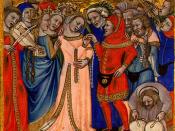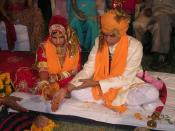The Filipino people have strange marriage customs. Among the Mangyans in the southern end of Oriental Mindoro, courtship takes a romantic flavor. Under the magic splendor of the moonlight, young man takes his native guitar and blanket, goes to the girl's hut, and sings to her. The girl comes out and goes with him to a forest. There, in some secluded spot, the man spread out a mat. The girl lies on it, while her suitor sits at her side pouring out his feelings in love songs the whole night through. The maid answers him in songs also. When the girl finally gives her consent, the two go to the girl's parents for their blessings.
In the Bicol lagpitaw (slingshot) custom, the parents of the boy propose by letter. The other party answers verbally or in writing. Sometimes, a son learns that he has proposed and been accepted only on his wedding day.
One of the easiest and quickest marriage ceremonies in the Philippines are performed among the Bagobos in Mindanao. Portions of rice are laid out on a banana leaf. Then the bride and bridegroom serve each other some rice, bump their heads together and are pronounced married.
Up north in Benguet, Mountain Province, Cupid wears a G-string; he is usually an older man armed with plenty of gab. It is during kanyaos that the Benguet Cupid begins to feel the match itch. Warmed up by the ricewine, the impish oldster known as kalon scouts for a prospect from among the men of marriageable age: from 16 up. The "chosen" would be enlightened on the joys of matrimony and the horrors of bachelorhood. After the victim has been properly "softened" he has only to name the girl and the rest would be taken care of by the matchmaker.


